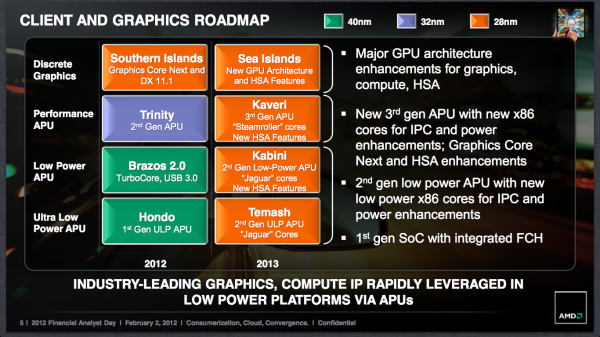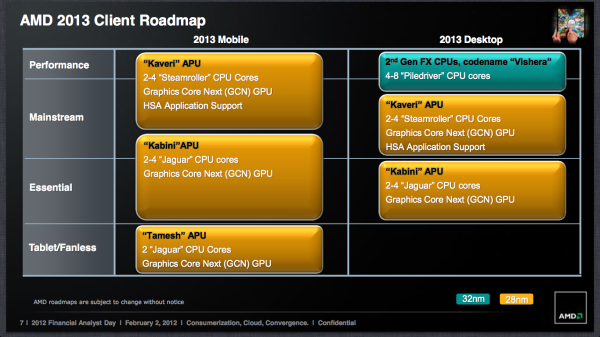Understanding AMD's Roadmap & New Direction
by Anand Lal Shimpi on February 2, 2012 6:16 PM EST- Posted in
- CPUs
- AMD
- Trade Shows
- AMD FAD 2012
We've been providing live coverage of AMD's 2012 Financial Analyst Day from Santa Clara today, but if you want a summary of the company's strategy under new CEO Rory Read you've come to the right place. Below you'll find links to everything we've published from AMD's FAD 2012:
AMD's Rory Read Outlines AMD's Future Strategy
AMD Outlines HSA Roadmap: Unified Memory for CPU/GPU in 2013, HSA GPUs in 2014
AMD is Open to Integrating 3rd Party IP in Future SoCs
AMD's Financial Analyst Day 2012 - Mark Papermaster, SVP & CTO Presentation
AMD: Flexible Around ISA
AMD Nods at Shorter Design Cycles, More Synthesized Designs
What AMD Views as Important: Tablets, Servers, Notebooks & GPUs
AMD & Compal Show Off 18mm Trinity Notebook
AMD's 2012 - 2013 Client CPU/GPU/APU Roadmap Revealed
AMD's 2012 - 2013 Server Roadmap: Abu Dhabi, Seoul & Delhi CPUs
AMD is Ambidextrous, Not Married to Any One Architecture, ARM in the Datacenter?
AMD's Tablet Architectures: Hondo at 4.5W, Future Sub-2W SoC
The name of the game for AMD in 2012 is execution. Far too often at previous AMD events we'd see a roadmap with no indication of whether or not AMD would actually stick to it. Plans were always aggressive and made sense, but execution rarely mirrored what was promised on paper. AMD in turn ended up delivering CPUs sometimes years after they were promised, which obviously didn't help grow the company.
Over the past few months Rory and his new management team at AMD have been restructuring the company to improve execution. As a much smaller company than Intel, AMD had an almost impossible task competing in the x86 space, but AMD should have also been far more agile than it was given its size. AMD's restructuring is supposed to fix these agility and execution problems. The proof will be in how well AMD is able to introduce products over the next 24 months.
As far as the roadmap goes, AMD already laid out what it hopes to accomplish by 2013. The best way to summarize AMD's next two years is: APUs and servers. On the APU side, we'll get updates to all of the current lines this year (Trinity & Brazos 2.0), but we'll also get a new 4.5W APU (Hondo) aimed at the Windows 8 tablet market. Now 4.5W is a bit high for a tablet but AMD has plans to bring even lower power architectures to market in the future. Next year we'll also see the first single-chip solutions from AMD: Kabini and Temash will integrate the I/O controller (SATA, USB ports, etc...) on-die. Intel is doing something similar with Haswell.
The big transition will happen next year, as AMD moves its entire APU stack from 32nm SOI to a bulk 28nm process at Global Foundries. This is an important move as it signifies the use of more easily synthesized designs, which enables AMD to bring out APUs in a quicker fashion and with lower design costs. Effectively everything follows the path laid by Brazos/Bobcat at this point. Note that AMD will be shipping 28nm APUs while Intel is well transitioned to 22nm, a gap that AMD has no intentions on narrowing. The process technology gap has almost always existed between AMD and Intel, but now AMD is taking a firm stance in saying that it has no intentions to blindly pursue the closing of that gap.
What once was a 3+ year design cycle for AMD CPUs and APUs now shrinks to less than 24 months (maybe even as short as 18 months) as a result of this migration to more easily synthesized designs. If this sounds a lot to you like the old GPU design cadence don't be surprised. AMD's APUs are, after all, largely made of GPU transistors that have always strayed from custom logic where possible. The big change is simply doing more non-custom x86 design.
Obviously AMD's ability to execute on this roadmap will depend heavily on Global Foundries delivering good yields at 28nm, however AMD does seem fairly confident at this point. That being said, 2013 is a very broad timeframe. Executing on the above roadmap sooner rather than later in 2013 will be the difference between a competitive AMD and one that's quickly written off.
I don't believe a move towards easily synthesized architectures is necessarily a bad thing. As long as AMD can deliver good performance at competitive prices the process technology really doesn't matter as much. Typically process technology was used as an enabler of good performance but as a newly fabless semiconductor, that strategy doesn't necessarily apply to AMD - at least not across all market segments. In other words, what works for Intel may not work for AMD.












84 Comments
View All Comments
another voice - Thursday, February 2, 2012 - link
intel also has to compete with itself on performance.Anyone looking at the highish end cpu (i5 or more) already has a cpu.
intel can only charge lots for its new cpu if they are significantly faster than whatever the customer currently owns, cause if its too much for a small performance gain then that generation will get skipped and customer waits for a new generation thus intel sells less.
Impulses - Thursday, February 2, 2012 - link
Yup, even if AMD shifts focus away from the desktop (which they should've done years ago) Intel won't have free reign to squeeze the market, one slip still gives a more agile AMD room to jump back in... At worst we'll see Intel's tick tock strategy shift to a slower pace, but Intel still derives much of the efficiency of newer mobile parts out of introducing newer smaller processes so...chizow - Friday, February 3, 2012 - link
Thank god someone else gets it. I've been hearing this "we need competition and AMD for cheap CPUs" meme repeated for the last 5 years. In the meantime, AMD still doesn't have a CPU that convincingly beats what Intel was offering then and yet, Intel continues to release newer, faster CPUs every year.But yes its just as you said, Intel is still competing with themselves and needs to provide incentive for users to actually "upgrade" to a faster CPU. Its not like CPUs expire or even "die" after a few years.
Its really very similar to other markets, like Apple with iPhone or Samsung with Galaxy. Or Madden or Modern Warfare. Even without significant competition, people will buy the latest and greatest but there needs to be enough reason to buy the next iteration.
chizow - Friday, February 3, 2012 - link
It makes you wonder though why AMD has no mobile strategy and no interest in even entertaining it.Beenthere - Thursday, February 2, 2012 - link
WHERE does anyone see AMD say they will not continue to deliver excellent desktop CPUs? WHERE? Show me WHERE you see this written or stated by an AMD exec? WHERE exactly did people come up with this nonsense idea?Let me guess when AMD said they were not going to compete directly with Intel everyone concluded that AMD was no longer going to produce high performance desktop CPUs. Well if you did then you thought WRONG. In addition to all of their current products they are also going to offer ULV products for tablets and other devices. These are additional revenue streams not a replacement for desktop CPU sales.
PLEASE stop whining. Vishera will be out this Fall and there are more desktop CPUs to follow.
Risforrocket - Thursday, February 2, 2012 - link
Well if AMD will not continue to design and produce high end CPUs then I will probably stop using the CPUs they do make in my high performace desktop. This is, I think, what people are trying to say, and they are right in saying just that.arjuna1 - Thursday, February 2, 2012 - link
Both the 2012 and 2013 client roadmaps show only Vishera as a performance desktop part, other than that, 3rd gen bulldozer, "steamroller", comes in 2013 as an APU part, unless the cpu part is a performing champ and the gpu part is a high end 7k series AMD will effectively, as Anand stated, abandoning the high end race.I fully understand that as a company the have nothing to catch up with intel and the focus is placed on other markets, but after all this years of supporting them one can only feel butt hurt to see them leaving us in the air.
As it looks the AM3+ platform is dead already, I don't know about you but I don't have bottomless pockets to have the luxury of investing in a new platform with it's end of the road already in sight.
Beenthere - Thursday, February 2, 2012 - link
There will be more desktop CPUs after Vishera. The AM3+ platform isn't dead because it will run Vishera. After that we'll see. AMD may have a few tricks up their sleeve as they are making Opterons to run on AM3+ sockets... You do recall Opteron 165's were fine OC'ers, right?Butt hurt? You must be kidding. I don't know how people reach such absurd conclusions about AMD not continuing with high end desktop CPUs. Yes mainstream will migrate to APUs - as I have said for over a year, but AMD will continue to offer top end desktop CPUs also.
arjuna1 - Thursday, February 2, 2012 - link
Actually, their idea is: their high end desktop parts are now their low end server parts, that's what they did with BD and we all know the end result, don't we??If Vishera is an APU I highly doubt it will run off AM3+, which is fine anyway, I wasn't expecting the AM socket to last forever, but the new trend is obvious, AMD is no longer interseted in the high end desktop market, and I'm not interested in APUs, and won't be couple of years still.
Sabresiberian summed it up pretty well:
they no longer are interested in supplying what I want, so we must part ways.
mak360 - Friday, February 3, 2012 - link
dude, your like a broken record "we must part ways", be gone and don`t let the door hit your ass on way out lol.if you're an high end user, you should be with intel anyway, so whats your point?